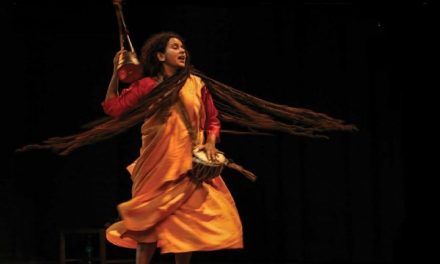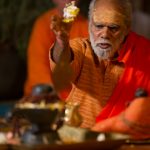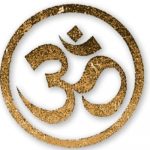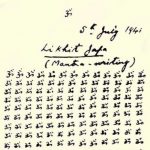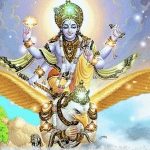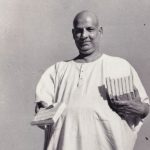 Yogic Symbols & Deities
Yogic Symbols & Deities
Why are there 33 million Gods and Goddesses? The true meaning of yogic symbols and deities, part 1.
By Swami Bhagavatananda
Once, a yogi was meditating for a very long time, visualising the form of the Divine and longing for its Darshan (presence). Gradually, the meditation deepened, and the Divine decided to appear in front of the yogi to give blessings. But before revealing itself, the Divine took a long look in the mirror, very carefully checking every little detail of its appearance. When asked for the reason, the Divine explained: “I want to make sure to show myself in the identical form, this yogi has been meditating on me”.
The Atman, the inner Self of all beings and the entire universe is nothing but cosmic consciousness, with – out names or forms, without beginning or end. But how to connect to something without name or form or qualities? We can only love something if we are able to establish a relationship with it, if we can open our heart to it. Therefore, Yoga mythology knows the concept of Ishwara or Ishtadevata, the personal God. There are 33 million Ishwaras or Gods and Goddesses to satisfy every possible shade of human temperament, but these many forms are nothing but colourful reflections of universal energies. They can be categorised into three main energies:
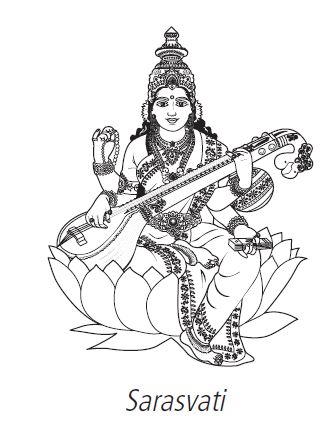 1. Creation Behind creation is the power of intelligence, the knowledge how to put things and together. It also includes the manifestation of mental concepts and ideas. Examples: Brahma; Saraswati and other forms of the Divine Mother.
1. Creation Behind creation is the power of intelligence, the knowledge how to put things and together. It also includes the manifestation of mental concepts and ideas. Examples: Brahma; Saraswati and other forms of the Divine Mother.
 2. Preservation This is the energy of balance, harmony, peace and stability. Examples: Vishnu and His various incarnations, the most important ones being Rama and Krishna.
2. Preservation This is the energy of balance, harmony, peace and stability. Examples: Vishnu and His various incarnations, the most important ones being Rama and Krishna.
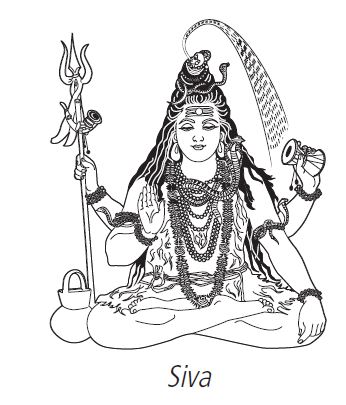 3. Destruction Contrary to common belief, this is actually a supremely positive energy. It means removing something old that has no value anymore to make room for something new. Examples: Ganesha, Siva.
3. Destruction Contrary to common belief, this is actually a supremely positive energy. It means removing something old that has no value anymore to make room for something new. Examples: Ganesha, Siva.
 Ganesha
Ganesha
Even people without much knowledge of Yoga mythology are familiar with the distinctive form of Ganesha, depicted with an elephant head, a huge belly and large ears. Ganesha is called Vigneshvara, the Lord of all obstacles, representing the energy of destruction in its most auspicious form. He clears all obstacles from our path, like an elephant making its way through the jungle, pushing aside with its powerful trunk everything which prevents it from moving forward. This is the force of willpower.
Whatever obstacles cannot be conquered that way, we rely on Ganesha’s faithful servant Mooshika, the little mouse, who makes up for its lack of strength by its ability to squeeze even into the tiniest places, showing us that sometimes humility and patience instead of brutal force are required to reach our goal. The little mouse has yet another sublime meaning: It holds a sweetmeat in its paws, looking up longingly at Ganesha for permission to gobble it up.
Mooshika is our lower, individual self, who wants to fully indulge in mundane pleasures, but is under the control of our higher Self, Ganesha, who generously allows it the occasional bite without granting it the whole treat! The same way we can live in the world without harm, if we let our higher Self guide us in enjoying material objects and sensual pleasures in moderation so that we don’t get caught up in them completely. We invoke Ganesha before starting any activity, whether worldly or spiritual, because without the removal of obstacles we cannot succeed in anything.
Ganesha is Ganapati, Lord of the Ganas, who are the spirits of the elements in nature. This means Ganesha helps us to live in harmony with the forces of nature (the five elements earth, water, fire, air and ether) in the world around us and to balance out their subtle manifestations in our body and mind, thus enabling us to experience peace of mind. In its highest aspect Ganesha represents the destruction of our biggest obstacle to Self-Realization which is the identi – fication with the ego that gives us the false sense of a limited, individual being.
How to attain Self-Realization?
First, we need to develop a liking for the spiritual path. With the axe of Viveka (discrimination) that he holds in one hand, Ganesha cuts our desire to live only for the gratification of the senses and with the noose in his other hand, he draws us to the divine life of Sadhana, spiritual practice. Then follows the practice of Sravana, which means listening carefully to spiritual teachings, symbolised by Ganesha’s large ears.
Next, we apply Manana, contemplation on what we have heard. To do this we invoke the support of Ganesha as Ekadanta, the one who has a single tusk, symbolising single-mindedness, i.e. the power of concentration. Finally, Ganesha helps us to experience Niddidhyasana, deep meditation and direct experience, achieved by first using our pure, sharp intellect to reflect on our true nature and in the end by even going beyond the intellect to attain the knowledge of the Self.
Therefore, Ganesha is also known as Buddhinath, the Lord of wisdom. Once we are aware of our true nature, we transcend all limitations, seeing no beginning or end. This is represented by Ganesha as Lambodara, the one who has a round belly, like a globe. Once the ego is conquered, we are beyond suffering and life is filled with sweetness – just like Ganesha who is always surrounded by plenty of sweetmeats and delicious fruits. Om Sri Maha Ganapataye Namah!
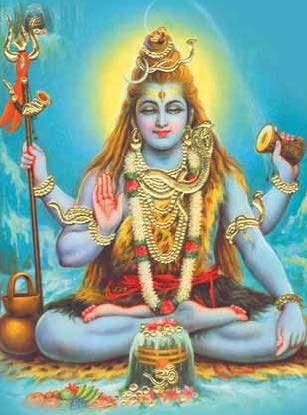 Siva
Siva
As Lord of transformation, Siva is also considered the God of meditation, since through meditation we transform our awareness from seeing ourselves as limited, separate beings to experiencing our Oneness with cosmic consciousness. Although responsible for the energy of destruction, Lord Siva is called “Sadasiva”, the One who is eternally auspicious and “Bhaktavatsala”, the One who is easily pleased with His devotees and fulfils their wishes. Why is that?
Well, once we have set ourselves sincerely to the task of destroying the lower qualities of our mind like jealousy, fear and anger through persistent Sadhana (spiritual practice), all positive qualities have room to rush in, filling our mind with a natural lightness and joy. Siva is also “Nilakantha”, the One who has a blue throat, caused by the terrible poison Halahala that threatened to destroy the whole universe and was swallowed by Lord Siva out of deep compassion and retained in his throat to protect all beings – those around him as well as those living in his stomach.
The poison of identification with the ego and the lower mind tries to destroy us inside out, but if we connect to the Divine and remember that we are the Atman, the immortal soul, we are protected from being burnt by the poison of worldliness. As Yogeshvara (Lord of Yogis), Siva is sitting in the meditation pose high up in the Himalayas with eyes half closed, symbolising that He uplifted his consciousness to a higher level, without refusing or negating the world itself. He is in the world and beyond the world at the same time, just like we should live our life. Just like a ferocious animal, anger can attack us all of a sudden and destroy our peace of mind mercilessly.
Siva smears his body with ashes from the cremation ground. This refers to Sivas power of destruction, but it also implies Vairagya, the wisdom of detachment, the knowledge that all things will pass and nothing except the Atman is eternal. Snakes are draped around Siva’s body, indicating an absolute fearlesness, that can only come out of the knowledge that there is no death because the Atman was never born and will never die. There is yet another beautiful symbolism in the snakes: no creature is too low or too impure to be accepted by the Divine.
Far from only tolerating the presence of all kind of creepy-crawlies around him, Siva lovingly picks them up and puts them around his neck – an eternal testimony to the infinite love of God towards all beings. Siva sports three eyes, representing the sun and the moon as source of all external light and the third eye in the middle of the forehead indicating the fire of knowledge that burns all ignorance and false identifications. It was with sparks from his third eye that Siva destroyed Kama, the God of lust. Kama embodies the sense of ego with all its limitations and desires.
But any identification with “Me” and “Mine” vanishes immediately in the Fire of Wisdom. Siva’s hair is adorned by the crescent moon, declaring Siva as the Lord and Master of time, since the waxing and waning moon symbolizes the passing of time. The sacred waters of Goddess Ganga flow from his matted locks, illustrating our true inner nature as one eternal stream of pure consciousness. Siva holds the Trishula, the trident, that stands for the three Gunas (Sattva, Rajas and Tamas = the qualities of harmony, excitement and inertia). Thus, we see that Siva can use the three Gunas but is not affected by them, the same as our inner Self is not tainted by any action or modification of nature.
In Siva’s hands is the Damaru, the drum, used by Siva to produce the sacred sound of AUM, the vibration that pervades and upholds the universe. Sometimes Siva is also shown holding a deer and an axe. With the axe, he destroys all our attachments and false identifications. The deer is caught by Siva in mid-jump – symbolizing our mind that is always ready to jump excitedly from one thought to the next but is firmly restrained and brought under control by the Higher Self, thus indicating the power of full and absolute concentration.
Siva is always accompanied by his faithful servant and devotee Nandi, the bull, representing the individual self in its pure, sattvic form, fully in tune with the Higher Self, Siva. Therefore, Siva is also called “Pasupati” the Lord of animals. At the entrance of most temples of Siva we find a statue of Nandi, whose gaze is firmly fixed on the image of Siva in the inner shrine. Nandi shows us how to lead a happy and fulfilled life where we perform all our actions as service to the Divine and never lose it out of sight, thus efficiently controlling our lower animal nature.
Besides his form as Yogeshvara, Lord of Yogis, Siva is also depicted in various forms indication the union of Siva and Shakti, i.e. of absolute consciousness and its manifested power in the world.
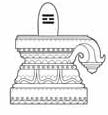 Siva Lingam
Siva Lingam
The base represents Shakti, the cosmic energy or the Divine Mother. The pillar rising from it stands for Brahman, the Absolute. Thus, Siva and Shakti belong together, they are just like the different sides of the same coin. The column of the Lingam points upwards, symbolising the uplift from individual to cosmic consciousness.
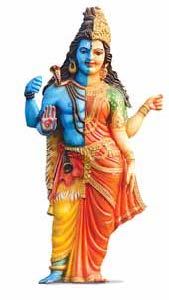 Ardha Narishvara (half male, half female)
Ardha Narishvara (half male, half female)
One side is in the form of Durga, the Shakti-aspect with all attributes of Durga, like the lion, a red sari and decked in jewellery. The other side depicts Siva with the snakes and matted hair. Again, this image illustrates the union of Siva and Shakti.
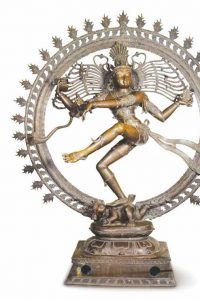 Siva Nataraja, the Lord of dance
Siva Nataraja, the Lord of dance
In the cosmic dance of Lord Siva, a world is created every time he lifts a foot and destroyed every time he sets it down. This is the constant, dynamic flow of energy or Shakti, nothing stays the same, everything changes. But Siva’s dance takes place within a perfect circle of flames. A circle has no beginning and no end, symbolising that, within all activities, the inner Self does not change but remains an unaffected witness. This is further emphasised by Siva dancing on the prostrate body of Apasmara, the demon of ignorance, who is trampled down and destroyed by the knowledge of Self-Realization. Om Namah Sivaya!
Swami Bhagavatananda is the co-director of the Ashram de Yoga Sivananda in France. email: [email protected]

